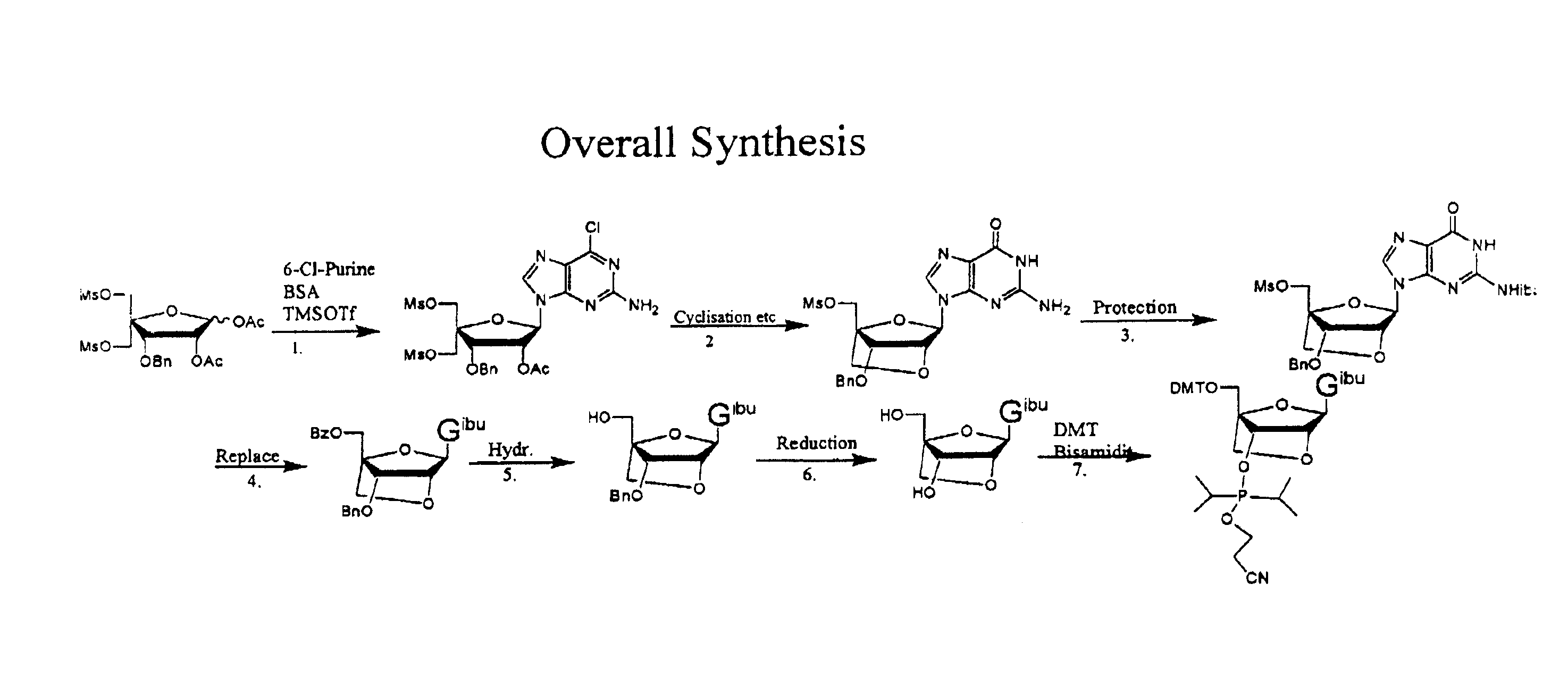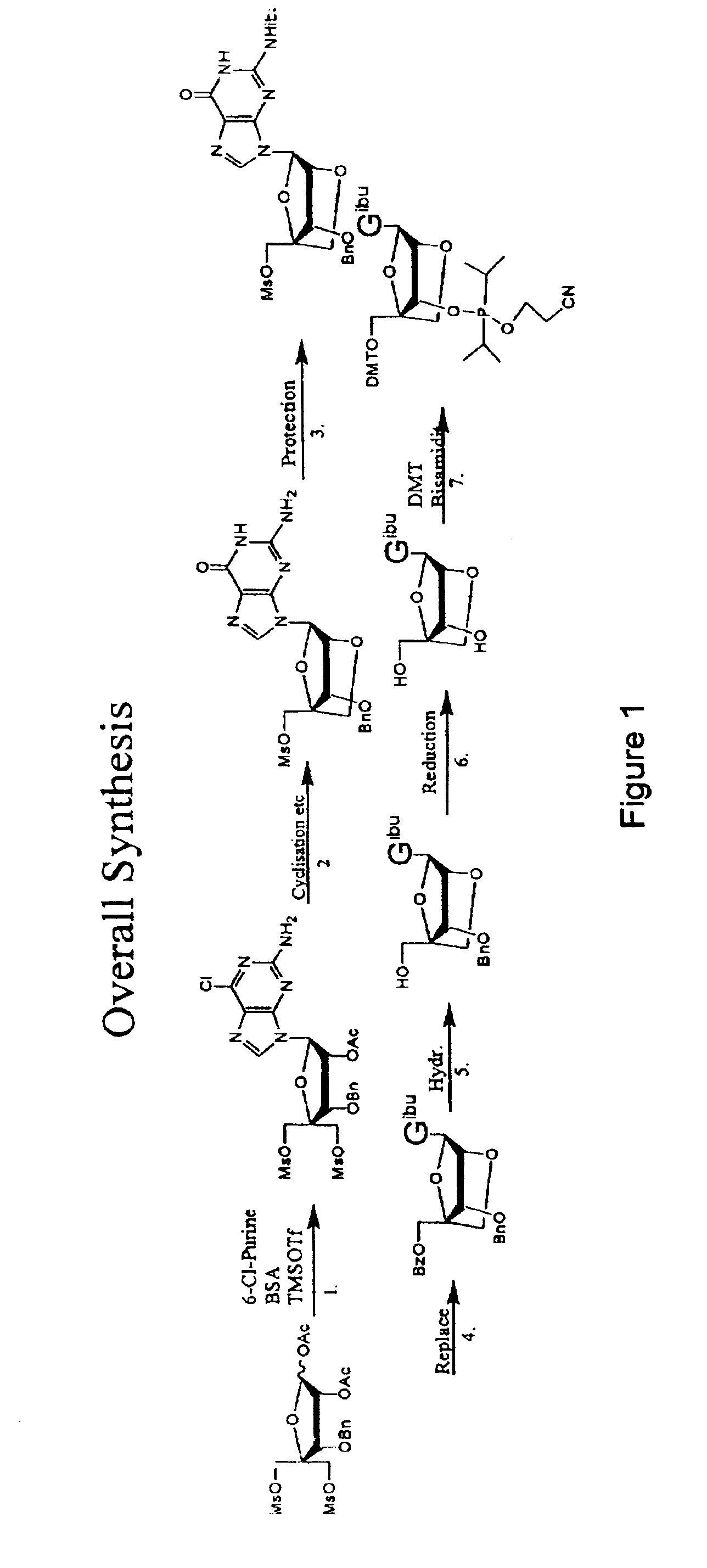Synthesis of purine locked nucleic acid analogues
a technology of locked nucleic acids and purine, applied in the field of new, can solve the problems of low overall yield
- Summary
- Abstract
- Description
- Claims
- Application Information
AI Technical Summary
Benefits of technology
Problems solved by technology
Method used
Image
Examples
example 1
3-O-benzyl-4-C-methanesulfonoxymethyl-5-methanesulfonyl-1,2-O-isopropylidene-β-D-ribofuranose (2)
[0097]A solution of 3-O-benzyl-4-C-hydroxymethyl-1,2-O-isopropylidene- -D-ribofuranose (1, 11.1 g, 40 mmol) (Youssefyeh, R. D.; Verheyden, J. P. H.; Moffatt, J. G., J. Org. Chem. 1979, 44, 1301) in dry pyridine (30 mL) was cooled in an ice-bath. Methanesulfonyl chloride (8.3 mL, 108 mmol) was then added under stirring. The mixture was allowed to warm up to room temperature and stirred for 1 hr. Ether (200 mL) was added and the solution was washed with water (3×200 mL). Organic layer was dried over Na2SO4 and concentrated under reduced pressure to give 16.4 g (98%) of compound (2) as slightly yellow solid.
example 2
1,2-O-acetyl-3-O-benzyl-4-C(methanesulfonyloxymethyl)-5-O-methanesulfonyl oxymethyl-)-β-D-ribofuranose (3)
[0098]1,2-O-isopropylidene-3-O-benzyl-4-C-methanesulfonyloxymethyl-5-O-methanesulfonyloxymethyl-β-D-ribofuranose (2, 20 g, 43 mmol) is dissolved in acetic acid (175 ml), acetic anhydride (28 ml) is added and finally 320 μl concentrated sulphuric acid. The solution is stirred over night. The solution is then evaporated to half volume at a water bath temperature at 35° C. Then water (300 ml) is added. The formed emulsion is extracted 3 times with ether (150 ml) and twice with DCM (at this point an emulsion is formed). The combined organic phases are washed twice with water and saturated HCO3− (intense CO2 evolution). The organic phase is evaporated to a syrup, redissolved in DCM (200 ml) and residual acetic anhydride is quenched by vigorously agitation in a two phase system of DCM and saturated HCO3− (150 ml). Additional HCO3− (solid) may be added if the aqueous phase turns acidic...
example 3
1-(2-O-acetyl-3-O-benzyl-4-C-methanesulfonyloxymethyl-5-O-methanesulfonyl-β-D-ribofuranosyl)-2-amino-6-chloro purine (4)
[0100]N,O-bis(trimethylsilyl)acetamide (29.6 g, 35 ml) was added to a stirred slurry of (3) (30 g, 58.8 mmol) and 2-amino-6-chloropurine (12 g, 70 mmol) in 1,2-dichloroethane (dried over sieves, 450 ml) and the mixture was refluxed for 40 min. to give a homogenous solution. The mixture was then removed from the heat and trimethylsilyltriflat (22 ml, 118 mmol) was added dropwise. The reaction mixture was refluxed for another 2 h. The reaction mixture was cooled to room temperature and a saturated aqueous solution of bicarbonate (400 ml) was added. The slurry was allowed to stir for 15 min, pH was adjusted to 7-8 using glacial acetic acid and the mixture was extracted with chloroform. The aqueous phase was extracted with AcOEt and chloroform and the organic phases were combined. The organic phase was washed with brine (2×250 ml) and bicarbonate (2×250 ml). The organi...
PUM
| Property | Measurement | Unit |
|---|---|---|
| Temperature | aaaaa | aaaaa |
| Temperature | aaaaa | aaaaa |
| Molar ratio | aaaaa | aaaaa |
Abstract
Description
Claims
Application Information
 Login to View More
Login to View More - R&D
- Intellectual Property
- Life Sciences
- Materials
- Tech Scout
- Unparalleled Data Quality
- Higher Quality Content
- 60% Fewer Hallucinations
Browse by: Latest US Patents, China's latest patents, Technical Efficacy Thesaurus, Application Domain, Technology Topic, Popular Technical Reports.
© 2025 PatSnap. All rights reserved.Legal|Privacy policy|Modern Slavery Act Transparency Statement|Sitemap|About US| Contact US: help@patsnap.com



